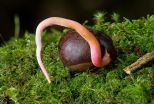Climate change in drylands
2014-11-19
(Press-News.org) Approximately 40 percent of the earth's surface is covered by drylands in which average annual precipitation is lower than evaporation. The changes projected to unfold in these areas in the course of climate change are alarming. Greater variations in annual and seasonal precipitation will lead to more frequent droughts and, presumably, longer drought periods. This means that drylands are among those areas most severely affected by climate change.
Research has thus far not adequately addressed the question of how strongly annual plant growth in pasture landscapes - hence the available food for livestock - is affected by droughts. Also, how predictable is the correlation? Yet this knowledge about vegetation stability would be essential for more accurate predictions of the effects of climate change in these areas. Over the past years, Dr. Jan Ruppert, an ecologist from the University of Cologne, has compiled hundreds of long-term studies on annual plant growth in drylands. Together with Dr. Anja Linstädter, the head of his working group at the University of Cologne, he has now completed his analysis of these data. The researchers are looking for an answer to the question of how droughts of varying intensity affect plant production - during and after the event. They are particularly interested in whether or not certain characteristics of the vegetation or the grazing regime affect the outcome. In this context, the scientists differentiate between two aspects of stability: on the one hand, the vegetation's durability to droughts of varying intensity (resistance), and on the other hand its ability to regenerate after a drought (recovery).
"We were surprised to see that the type of ecosystem (biome) is a rather poor indicator of vegetation stability in the face of drought. It does not make a large difference whether a drought occurs in a savanna, grassland or shrubland. The decisive factor is the dominant herbaceous life history - that is, whether we are dealing with annual or perennial plants", Ruppert explains. Drylands that are dominated by annual plants are more severely affected during droughts, but recover more quickly afterwards. Areas in which perennial plants dominate exhibit the opposite trend. The effect of the grazing regime on vegetation stability in the face of drought is also highly dependent on whether one is dealing with annual or perennial plants. Enduring communities of plants will react to grazing with a lower drought resistance. Grazing does not, however, have a significant effect on resistance in areas where annual plants dominate. "Our results indicate that the vegetation of drylands is not capable of optimizing its resistance and recovery potential at the same time," Linstädter concludes.
Besides this comprehensive analysis, the researchers are also hazarding a prognosis for the future. On the basis of 500 analyzed droughts, they can fairly accurately predict the reduction in plant production caused by droughts. A centennial-scale drought would reduce the production of plant biomass by about 45 or 72 percent - depending on whether the dominant plant life is perennial or annual. "This is an alarming finding, particularly if we consider that 'centennial-scale droughts' by today's standards will occur much more frequently in the future," Linstädter cautions.
"The good news is that drylands have a relatively good pre-adaption to droughts. The bad news is that the combined effects of climate change and overgrazing could have detrimental effects on the capability of drylands to resist droughts and recover from them," Ruppert sums up. "The progressing loss of perennial grasses and decreasing vegetation cover in drylands can serve as important warning signs."
INFORMATION:
Article:
https://dx.doi.org/10.1111/gcb.12777
For queries, please contact:
Dr. Jan C. Ruppert
Range Ecology and Range Management (Working Group Linstädter)
Faculty of Mathematics and Natural Sciences
University of Cologne
jan.ruppert(at)uni-koeln.de
Dr. Anja Linstädter
Range Ecology and Range Management (Working Group Linstädter)
Faculty of Mathematics and Natural Sciences
University of Cologne
anja.linstaedter(at)uni-koeln.de
Internet:
http://www.botanik.uni-koeln.de/range_ecology.html
ELSE PRESS RELEASES FROM THIS DATE:
2014-11-19
Time ravages mountains, as it does people. Sharp features soften, and bodies grow shorter and rounder. But under the right conditions, some mountains refuse to age. In a new study, scientists explain why the ice-covered Gamburtsev Mountains in the middle of Antarctica looks as young as they do.
The Gamburtsevs were discovered in the 1950s, but remained unexplored until scientists flew ice-penetrating instruments over the mountains 60 years later. As this ancient hidden landscape came into focus, scientists were stunned to see the saw-toothed and towering crags of much ...
2014-11-19
Researchers from China, the Philippines and LSTM have today published a new systematic review of reminder systems to improve patient adherence to tuberculosis (TB) treatment. Reminder systems include prompts in advance of a forthcoming appointment to help ensure the patients attend, and also actions when people miss an appointment, such as phoning them or arranging a home visit. This review is the latest in a suite of reviews produced by authors from the Cochrane Infectious Diseases Group, hosted at LSTM, evaluating interventions to improve adherence to TB treatment. Effective ...
2014-11-19
Washington, D.C. - November 19, 2014 - Lumosity is presenting new research today at the 2014 Society for Neuroscience conference on how lifestyle factors such as sleep, mood and time of day impact cognitive gameplay performance. The study, titled "Estimating sleep, mood and time of day effects in a large database of human cognitive performance," analyzed over 60 million data points from 61,407 participants and found that memory, speed, and flexibility tasks peaked in the morning, while crystallized knowledge tasks such as arithmetic and verbal fluency peaked in the afternoon. ...
2014-11-19
An international team of scientists, coordinated by a researcher from the U. of Granada, has found that seed dormancy (a property that prevents germination under non-favourable conditions) was a feature already present in the first seeds, 360 million years ago.
Seed dormancy is a phenomenon that has intrigued naturalists for decades, since it conditions the dynamics of natural vegetation and agricultural cycles. There are several types of dormancy, and some of them are modulated by environmental conditions in more subtle ways than others.
In an article published in the ...
2014-11-19
Quasars are galaxies with very active supermassive black holes at their centres. These black holes are surrounded by spinning discs of extremely hot material that is often spewed out in long jets along their axes of rotation. Quasars can shine more brightly than all the stars in the rest of their host galaxies put together.
A team led by Damien Hutsemékers from the University of Liège in Belgium used the FORS instrument on the VLT to study 93 quasars that were known to form huge groupings spread over billions of light-years, seen at a time when the Universe ...
2014-11-19
PROVIDENCE, R.I. [Brown University] -- A widely presumed problem of aging is that the brain becomes less flexible -- less plastic -- and that learning may therefore become more difficult. A new study led by Brown University researchers contradicts that notion with a finding that plasticity did occur in seniors who learned a task well, but it occurred in a different part of the brain than in younger people.
When many older subjects learned a new visual task, the researchers found, they unexpectedly showed a significantly associated change in the white matter of the brain. ...
2014-11-19
Professor Dan Davis and his team at the Manchester Collaborative Centre for Inflammation Research, working in collaboration with global healthcare company GSK, investigated how different types of immune cells communicate with each other - and how they kill cancerous or infected cells. Their research has been published in Nature Communications.
Professor Davis says: "We studied the immune system and then stumbled across something that may explain why some drugs don't work as well as hoped. We found that immune cells secrete molecules to other cells across a very small ...
2014-11-19
A recent study by an Indiana University researcher has found that adolescents' alcohol use is influenced by their close friends' use, regardless of how much alcohol they think their general peers consume.
Jonathon Beckmeyer, assistant professor in the Department of Applied Health Science at the IU School of Public Health-Bloomington and author of the study, said his research generally focuses on the onset of teen alcohol use and how their social relationships shape those experiences.
"We've known for a long time that friends and peers have an influence on individual ...
2014-11-19
SAN FRANCISCO, Nov. 19, 2014 -- Hox genes are master body-building genes that specify where an animal's head, tail and everything in between should go. There's even a special Hox gene program that directs the development of limbs and fins, including specific modifications such as the thumb in mice and humans. Now, San Francisco State University researchers show that this fin- and limb-building genetic program is also utilized during the development of other vertebrate features.
The discovery means this ancient genetic program is employed in a variety of features beyond ...
2014-11-19
A new study, published online in Brain: A Journal of Neurology today, followed 43,368 individuals in Sweden for an average of 12.6 years to examine the impact of physical activity on Parkinson's disease risk. It was found that "a medium amount" of physical activity lowers the risk of Parkinson's disease.
Karin Wirdefeldt of the Karolinska Institutet in Stockholm and her colleagues used the Swedish National March Cohort to analyse comprehensive information on physical activity of all kinds. They assessed household and commuting activity, occupational activity, leisure ...
LAST 30 PRESS RELEASES:
[Press-News.org] Climate change in drylands



